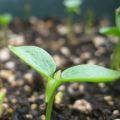The increasing human population is placing greater pressure on soil and water resources and threatening our ability to produce sufficient food, feed, and fiber. As a result, there is a growing consensus within our global community that the protection of natural resources and implementation of environmentally and economically sound agriculture practices is of the utmost priority.
The basic physical, chemical, and biological properties of soils must be considered to maintain sustainable agricultural practices. Through the study of soil science the importance of this heterogeneous assemblage of minerals, organic matter, organisms, air, and water as a key component of our global environment becomes self-evident. Soils provide a wide range of important ecosystem services — such as a living filter for water, a sink for carbon, a regulator of atmospheric gasses, and a medium for plant growth — which helps to sustain all life on this plant.
Scientific research continues to reveal how Earth system processes are often driven by reactions taking place in the soil. However, human evolution, and our agricultural dependence, has altered the scope of these soil processes and drastically changed the face of our planet. With the exception of minor contributions from aquaculture and hydroponics, it is the soil to which we are tied for most of our agricultural products. Over the course of our history we have relied on our ability to alter landscapes, manage soil and water, and domesticate crops and animals to help meet our basic human requirements.
Our stewardship of soil, water, and biological (e.g., microbes, insects, animals, plants) resources is a critical component of sustainable agriculture. This approach to agriculture ensures that food and fiber production is conducted in a way that minimizes degradation of natural resources and permits long-term production in an economically viable way. Sustainable agriculture takes advantage of traditional agricultural techniques, as well as the most recent technological advances. Tied closely to sustainable agriculture, are the concepts of food security and safety, which are based around the fact that all people should have access to safe and nutritious food to sustain a healthy life.
Recently developed biotechnologies are providing new and exciting possibilities for enhancing both food and energy production. With increased awareness of agroecosystem functioning and best management practices, biotechnology and agricultural practices have evolved together to solve a range of problems and promote agricultural sustainability. Today, farming practices which reduce erosion (e.g., no till, perennial grains) are being combined with the use of hardy and pest resistant crops (e.g., selective cross breeding, genetic engineering) to enhance long-term food and biofuel production. Of course, change rarely comes easily, and some of these practices are facing opposition from both producers and consumers. The human population is predicted to approach 10 billion by 2050 and it will be very interesting to observe how agricultural practices adapt to maintain adequate food security and energy generation.
The summaries which follow in this topic room provide an overview of these topics and delve into some fascinating related details. In addition, these articles address relevant soil and agricultural processes, and begin to discuss what humans can do to influence them for our own benefit. Through exploration of these topics an introductory knowledge of soil science, agricultural practices, and biotechnology in agriculture can be achieved.














